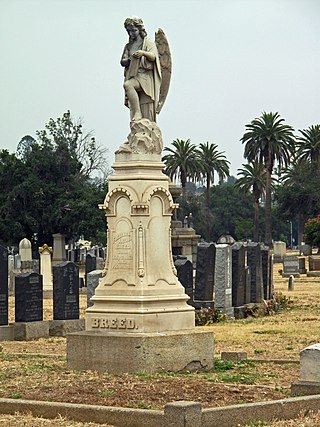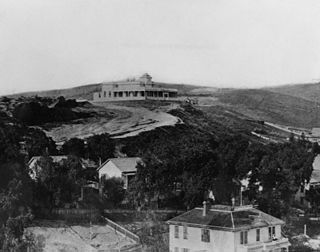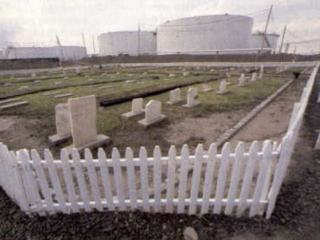
A cemetery, burial ground, gravesite or graveyard is a place where the remains of dead people are buried or otherwise interred. The word cemetery implies that the land is specifically designated as a burial ground and originally applied to the Roman catacombs. The term graveyard is often used interchangeably with cemetery, but a graveyard primarily refers to a burial ground within a churchyard.

A mausoleum is an external free-standing building constructed as a monument enclosing the burial chamber of a deceased person or people. A mausoleum without the person's remains is called a cenotaph. A mausoleum may be considered a type of tomb, or the tomb may be considered to be within the mausoleum.

A potter's field, paupers' grave or common grave is a place for the burial of unknown, unclaimed or indigent people. "Potter's field" is of Biblical origin, referring to Akeldama, stated to have been purchased after Judas Iscariot's suicide by the high priests of Jerusalem with the coins that had been paid to Judas for his identification of Jesus. The priests are stated to have acquired it for the burial of strangers, criminals, and the poor, the coins paid to Judas being considered blood money. Prior to Akeldama's use as a burial ground, it had been a site where potters collected high-quality, deeply red clay for the production of ceramics, thus the name potters' field.

Evergreen Memorial Park & Crematory is a cemetery in the East Side neighborhood of Boyle Heights, Los Angeles, California.

The Hudson County Burial Grounds are also known as the Secaucus Potter's Field and Snake Hill Cemetery and it is located in Secaucus, New Jersey.

Chavez Ravine is a shallow canyon in Los Angeles, California. It sits in a large promontory of hills north of downtown Los Angeles, next to Major League Baseball's Dodger Stadium. Chavez Ravine was named for Julian Chavez, a Los Angeles councilman in the 19th century who originally purchased the land in the Elysian Park area.
The Hebrew Free Burial Association (HFBA) was established in 1888 as a free burial society serving the residents of Manhattan's Lower East Side. It was incorporated as a non-profit organization with the name of Chebra Agudas Achim Chesed Shel Emeth on January 25, 1889. As the need grew in adjacent Jewish communities, HFBA also grew to serve the broader metropolitan area of New York City. HFBA is currently the largest free burial society outside of Israel. In 1965, it changed its official name to Chebra Agudas Achim Chesed Shel Emeth Hebrew Free Burial Association, Inc.
The Chinese Consolidated Benevolent Association (CCBA) is a historical Chinese association established in various parts of the United States and Canada, with large Chinese communities. It is also known by other names, such as Chinese Six Companies in San Francisco, especially when it began, in the 19th century; Chong Wa Benevolent Association in Seattle, Washington; and United Chinese Society in Honolulu, Hawaii. The association's clientele were Chinese immigrants of the late 19th and early 20th centuries, who came mainly from eight districts on the west side of the Pearl River Delta in Guangdong, southern China, and their descendants. The latter wave of Chinese immigrants, after 1965, who came from a much wider area of China, did not experience the level of hostilities faced by the pioneers and did not join the CCBA, which greatly lessened its influence.

Toowong Cemetery is a heritage-listed cemetery on the corner of Frederick Street and Mt Coot-tha Road, Toowong, City of Brisbane, Queensland, Australia. It was established in 1866 and formally opened in 1875. It is Queensland's largest cemetery and is located on forty-four hectares of land at the corner of Frederick Street and Mount Coot-tha Road approximately four and a half kilometres west of Brisbane. It was previously known as Brisbane General Cemetery. It was added to the Queensland Heritage Register on 31 December 2002.

Fort Moore was the second of two historic U.S. Military Forts in Los Angeles, California, during the Mexican–American War. It lay straight above the junction of the Hollywood Freeway and Broadway, on an historic hill that once sheltered the old Plaza.
The Potter's Field Cemetery in Omaha, Nebraska, United States is located on a 5-acre (20,000 m2) plot of land at 5000 Young Street near the intersections of Young Street and Mormon Bridge Road. Like all Potter's Fields, it was used to bury poor people or people with no known identity from across the Omaha area. The cemetery was active from 1887 to 1957.

Chinese Historical Society of Southern California is an organization based in Los Angeles Chinatown, California.

Constable Hook Cemetery is the name used to refer to two cemeteries on Constable Hook in Bayonne, New Jersey, the extant Bayonne Constable Hook Cemetery and the no longer existing Van Buskerck Family Burial Ground. Both were founded by members of the van Buskirk family, descendants of the cape's first settler, Pieter Van Buskirk. In 1906 the Standard Oil Company purchased the family land to expand their refinery, already the largest in the world at the time. Myths and historical inaccuracies have led to confusion about the two burial grounds.
Columbian Harmony Cemetery was an African-American cemetery that formerly existed at 9th Street NE and Rhode Island Avenue NE in Washington, D.C., in the United States. Constructed in 1859, it was the successor to the smaller Harmoneon Cemetery in downtown Washington. All graves in the cemetery were moved to National Harmony Memorial Park in Landover, Maryland, in 1959. The cemetery site was sold to developers, and a portion used for the Rhode Island Avenue – Brentwood Washington Metro station.

Springwood Cemetery is a historic cemetery in Greenville, South Carolina, listed on the National Register of Historic Places. It is the oldest municipal cemetery in the state and has approximately 7,700 marked, and 2,600 unmarked, graves.

The North Brisbane Burial Ground was a former cemetery in the Town of Brisbane, Queensland, Australia. It was in the area now known as the suburbs of Milton and Paddington. It was also known as North Brisbane Cemetery, Paddington Cemetery and Milton Cemetery.

Woodland Cemetery is a historic rural cemetery located at 6901 Woodland Avenue in Cleveland, Ohio. Established in 1853, it became Cleveland's main public cemetery after its founding and remained so for the next half-century. It fell into extreme disrepair, and most of its outstanding architectural features dismantled or demolished. In 1986, Woodland Cemetery was added to the National Register of Historic Places. The cemetery has since undergone restoration.

The First Jewish site in Los Angeles is a first Jewish cemetery in the City of Los Angeles, opened in 1855 by Hebrew Benevolent Society of Los Angeles, the first charitable organization in Los Angeles. The First Jewish site in Los Angeles was designated a California Historic Landmark on Jan. 26, 1968. The First Jewish site in Los Angeles is located at Chavez Ravine in Los Angeles in Los Angeles County. In 1902 the cemetery was moved, a California Historic Landmark is at the place of the original cemetery. The Hebrew Benevolent Society of Los Angeles was founded in 1854 for the purpose of "…procuring a piece of ground suitable for the purpose of a burying ground for the deceased of their own faith, and also to appropriate a portion of their time and means to the holy cause of benevolence…,". The Hebrew Benevolent Society of Los Angeles received the deed to land from the Los Angeles City Council on April 9, 1855. With this land they established the first Jewish cemetery in Los Angeles at Lilac Terrace and Lookout Drive in Chavez Ravine. The site is now the current site of Dodger Stadium and the Los Angeles Fire Department's Frank Hotchkin Memorial Training Center.
New Helvetia Cemetery, initially named Sutter Fort Burying Ground, is a defunct cemetery founded in c. 1845 and closed in 1912, formerly located at northeast corner of Alhambra Boulevard and J Street in the East Sacramento neighborhood of Sacramento, California. It was the first cemetery in the city of Sacramento.














